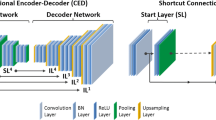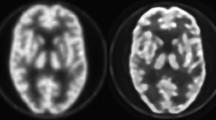Abstract
Objective
To obtain attenuation-corrected PET images directly from non-attenuation-corrected images using a convolutional encoder-decoder network.
Methods
Brain PET images from 129 patients were evaluated. The network was designed to map non-attenuation-corrected (NAC) images to pixel-wise continuously valued measured attenuation-corrected (MAC) PET images via an encoder-decoder architecture. Image quality was evaluated using various evaluation metrics. Image quantification was assessed for 19 radiomic features in 83 brain regions as delineated using the Hammersmith atlas (n30r83). Reliability of measurements was determined using pixel-wise relative errors (RE; %) for radiomic feature values in reference MAC PET images.
Results
Peak signal-to-noise ratio (PSNR) and structural similarity index metric (SSIM) values were 39.2 ± 3.65 and 0.989 ± 0.006 for the external validation set, respectively. RE (%) of SUVmean was − 0.10 ± 2.14 for all regions, and only 3 of 83 regions depicted significant differences. However, the mean RE (%) of this region was 0.02 (range, − 0.83 to 1.18). SUVmax had mean RE (%) of − 3.87 ± 2.84 for all brain regions, and 17 regions in the brain depicted significant differences with respect to MAC images with a mean RE of − 3.99 ± 2.11 (range, − 8.46 to 0.76). Homogeneity amongst Haralick-based radiomic features had the highest number (20) of regions with significant differences with a mean RE (%) of 7.22 ± 2.99.
Conclusions
Direct AC of PET images using deep convolutional encoder-decoder networks is a promising technique for brain PET images. The proposed deep learning method shows significant potential for emission-based AC in PET images with applications in PET/MRI and dedicated brain PET scanners.
Key Points
• We demonstrate direct emission-based attenuation correction of PET images without using anatomical information.
• We performed radiomics analysis of 83 brain regions to show robustness of direct attenuation correction of PET images.
• Deep learning methods have significant promise for emission-based attenuation correction in PET images with potential applications in PET/MRI and dedicated brain PET scanners.





Similar content being viewed by others
Abbreviations
- AC:
-
Attenuation correction
- CGAN :
-
Conditional generative adversarial networks
- CNN :
-
Convolutional neural network
- Deep-DAC:
-
Deep direct attenuation correction
- FOV :
-
Field of view
- GLCM :
-
Gray-level co-occurrence matrix
- GLRLM:
-
Gray-level run length matrix
- GLZLM:
-
Gray-level size zone matrix
- GPU:
-
Graphics processing unit
- LRE:
-
Long-run emphasis
- MAC :
-
Measured attenuation corrected
- MAE :
-
Mean absolute error
- MLAA :
-
Maximum likelihood reconstruction of activity and attenuation
- MRI:
-
Magnetic resonance imaging
- MSE :
-
Mean squared error
- NAC :
-
Non-attenuation corrected
- OSEM:
-
Ordered subset expectation maximization
- PET:
-
Positron emission tomography
- PSNR :
-
Peak signal-to-noise ratio
- RBM :
-
Restricted Boltzmann machine
- RE:
-
Relative errors
- ReLU :
-
Rectified linear unit
- RFV :
-
Radiomic feature values
- RMSE :
-
Root mean squared error
- RP:
-
Run percentage
- SRE:
-
Short-run emphasis
- SSIM :
-
Structural similarity index metrics
- SUV:
-
Standard uptake value
- SZE :
-
Size zone emphasis
- TLG:
-
Total lesion glycolysis
- TOF:
-
Time of flight
- UTE :
-
Ultra-short echo time
- VOI :
-
Volumes of interest
- ZP:
-
Zone percentage
- ZTE :
-
Zero echo time
References
Catana C, Procissi D, Wu Y et al (2008) Simultaneous in vivo positron emission tomography and magnetic resonance imaging. Proc Natl Acad Sci U S A 105:3705–3710
Zanotti-Fregonara P, Chen K, Liow J-S, Fujita M, Innis RB (2011) Image-derived input function for brain PET studies: many challenges and few opportunities. J Cereb Blood Flow Metab 31:1986–1998
Schöll M, Lockhart SN, Schonhaut DR et al (2016) PET imaging of tau deposition in the aging human brain. Neuron 89:971–982
Sedvall G, Farde L, Persson A, Wiesel FA (1986) Imaging of neurotransmitter receptors in the living human brain. Arch Gen Psychiatry 43:995–1005
Innis RB, Cunningham VJ, Delforge J et al (2007) Consensus nomenclature for in vivo imaging of reversibly binding radioligands. J Cereb Blood Flow Metab 27:1533–1539
Okamura N, Yanai K (2017) Brain imaging: applications of tau PET imaging. Nat Rev Neurol 13:197
Nordberg A, Rinne JO, Kadir A, Långström B (2010) The use of PET in Alzheimer disease. Nat Rev Neurol 6:78
Sarikaya I (2015) PET studies in epilepsy. Am J Nucl Med Mol Imaging 5:416
Lammertsma AA (2017) Forward to the past: the case for quantitative PET imaging. J Nucl Med 58:1019–1024
Mehranian A, Arabi H, Zaidi H (2016) Vision 20/20: magnetic resonance imaging-guided attenuation correction in PET/MRI: challenges, solutions, and opportunities. Med Phys 43:1130–1155
Delso G, Nuyts J (2018) PET/MRI: attenuation correction. In: Iagaru A, Hope T, Veit-Haibach P (eds) PET/MRI in Oncology. Springer, Cham, pp 53–75
Yang J, Wiesinger F, Kaushik S et al (2017) Evaluation of sinus/edge-corrected zero-echo-time–based attenuation correction in brain PET/MRI. J Nucl Med 58:1873–1879
Khateri P, Saligheh Rad H, Jafari AH et al (2015) Generation of a four-class attenuation map for MRI-based attenuation correction of PET data in the head area using a novel combination of STE/Dixon-MRI and FCM clustering. Mol Imaging Biol 17:884–892
Mehranian A, Zaidi H (2015) Joint estimation of activity and attenuation in whole-body TOF PET/MRI using constrained Gaussian mixture models. IEEE Trans Med Imaging 34:1808–1821
Akbarzadeh A, Ay MR, Ahmadian A, Alam NR, Zaidi H (2013) MRI-guided attenuation correction in whole-body PET/MR: assessment of the effect of bone attenuation. Ann Nucl Med 27:152–162
Shandiz MS, Rad HS, Ghafarian P, Karam MB, Akbarzadeh A, Ay MR (2017) MR-guided attenuation map for prostate PET-MRI: an intensity and morphologic-based segmentation approach for generating a five-class attenuation map in pelvic region. Ann Nucl Med 31:29–39
Khateri P, Saligheh Rad H, Fathi A, Ay MR (2013) Generation of attenuation map for MR-based attenuation correction of PET data in the head area employing 3D short echo time MR imaging. Nucl Instrum Meth A 702:133–136
Kazerooni AF, A’arabi MH, Ay M, Saligheh Rad H (2015) Generation of MR-based attenuation correction map of PET images in the brain employing joint segmentation of skull and soft-tissue from single short-TE MR imaging modality. In: Gao F, Shi K, Li S (eds) Computational Methods for Molecular Imaging. Lecture Notes in Computational Vision and Biomechanics, vol 22. Springer, Cham, pp 139–147
Hope T, Tosun D, Khalighi MM et al (2017) Improvement in quantitative amyloid imaging using ZTE-based attenuation correction in PET/MRI. J Nucl Med 58:645
Shandiz MS, Saligheh Rad H, Ghafarian P, Yaghoubi K, Ay MR (2018) Capturing bone signal in MRI of pelvis, as a large FOV region, using TWIST sequence and generating a 5-class attenuation map for prostate PET/MRI imaging. Mol Imaging 17:1536012118789314
Defrise M, Rezaei A, Nuyts J (2012) Time-of-flight PET data determine the attenuation sinogram up to a constant. Phys Med Biol 57:885
Sevigny J, Suhy J, Chiao P et al (2016) Amyloid PET screening for enrichment of early-stage Alzheimer disease clinical trials. Alzheimer Dis Assoc Disord 30:1–7
Censor Y, Gustafson DE, Lent A, Tuy H (1979) A new approach to the emission computerized tomography problem: simultaneous calculation of attenuation and activity coefficients. IEEE Trans Nucl Sci 26:2775–2779
Rezaei A, Defrise M, Nuyts J (2014) ML-reconstruction for TOF-PET with simultaneous estimation of the attenuation factors. IEEE Trans Med Imaging 33:1563–1572
Mehranian A, Zaidi H (2015) Clinical assessment of emission-and segmentation-based MR-guided attenuation correction in whole-body time-of-flight PET/MR imaging. J Nucl Med 56:877–883
Hemmati H, Kamali-Asl A, Ghafarian P, Ay MR (2018) Reconstruction/segmentation of attenuation map in TOF-PET based on mixture models. Ann Nucl Med 1–11, 32(7):474–484
LeCun Y, Bengio Y, Hinton G (2015) Deep learning. Nature 521:436
Yang Q, Li N, Zhao Z, Fan X, Chang EI, Xu Y (2018) MRI image-to-image translation for cross-modality image registration and segmentation. arXiv:180106940
Han X (2017) MR-based synthetic CT generation using a deep convolutional neural network method. Med Phys 44:1408–1419
Ben-Cohen A, Klang E, Raskin SP et al (2018) Cross-modality synthesis from CT to PET using FCN and GAN networks for improved automated lesion detection. arXiv:180207846
Jin C-B, Jung W, Joo S et al (2018) Deep CT to MR synthesis using paired and unpaired data. arXiv:180510790
Liu F, Jang H, Kijowski R, Bradshaw T, McMillan AB (2017) Deep learning MR imaging–based attenuation correction for PET/MR imaging. Radiology 286:676–684
Gong K, Yang J, Kim K, El Fakhri G, Seo Y, Li Q (2018) Attenuation correction for brain PET imaging using deep neural network based on Dixon and ZTE MR images. Phys Med Biol 63(12):125011
Spuhler KD, Gardus J, Gao Y, DeLorenzo C, Parsey R, Huang C (2018) Synthesis of patient-specific transmission image for PET attenuation correction for PET/MR imaging of the brain using a convolutional neural network. J Nucl Med 60(4):555–560
Lu Y, Fontaine K, Germino M et al (2018) Investigation of sub-centimeter lung nodule quantification for low-dose PET. IEEE TRPMS 2:41–50
Abadi M, Barham P, Chen J et al (2016) TensorFlow: a system for large-scale machine learning. In 12th USENIX Symposium on Operating Systems Design and Implementation, pp 265–283
Hammers A, Allom R, Koepp MJ et al (2003) Three-dimensional maximum probability atlas of the human brain, with particular reference to the temporal lobe. Hum Brain Mapp 19:224–247
Shiri I, Rahmim A, Ghaffarian P, Geramifar P, Abdollahi H, Bitarafan-Rajabi A (2017) The impact of image reconstruction settings on 18F-FDG PET radiomic features: multi-scanner phantom and patient studies. Eur Radiol 27:4498–4509
van Griethuysen JJM, Fedorov A, Parmar C et al (2017) Computational radiomics system to decode the radiographic phenotype. Cancer Res 77:e104–e107
Hemmati H, Kamali-Asl A, Ghafarian P, Ay M (2018) Mixture model based joint-MAP reconstruction of attenuation and activity maps in TOF-PET. J Instrum 13:P06005
Rezaei A, Defrise M, Bal G et al (2012) Simultaneous reconstruction of activity and attenuation in time-of-flight PET. IEEE Trans Med Imaging 31:2224–2233
Salomon A, Goedicke A, Schweizer B, Aach T, Schulz V (2011) Simultaneous reconstruction of activity and attenuation for PET/MR. IEEE Trans Med Imaging 30:804–813
Ladefoged CN, Law I, Anazodo U et al (2017) A multi-centre evaluation of eleven clinically feasible brain PET/MRI attenuation correction techniques using a large cohort of patients. Neuroimage 147:346–359
Funding
This study has received funding the Tehran University of Medical Sciences under grant number 97-01-30-38001.
Author information
Authors and Affiliations
Corresponding authors
Ethics declarations
Guarantor
The scientific guarantor of this publication is Mohammad Reza Ay, PhD, Professor of Medical Physics.
Conflict of interest
The authors of this manuscript declare no relationships with any companies, whose products or services may be related to the subject matter of the article.
Statistics and biometry
One of the authors has significant statistical expertise. And no complex statistical methods were necessary for this paper.
Informed consent
Written informed consent was waived by the Institutional Review Board.
Ethical approval
Institutional Review Board approval was obtained.
Methodology
• Retrospective
• Experimental
• Performed at one institution
Additional information
Publisher’s note
Springer Nature remains neutral with regard to jurisdictional claims in published maps and institutional affiliations.
Electronic supplementary material
ESM 1
(DOCX 184 kb)
Rights and permissions
About this article
Cite this article
Shiri, I., Ghafarian, P., Geramifar, P. et al. Direct attenuation correction of brain PET images using only emission data via a deep convolutional encoder-decoder (Deep-DAC). Eur Radiol 29, 6867–6879 (2019). https://doi.org/10.1007/s00330-019-06229-1
Received:
Revised:
Accepted:
Published:
Issue Date:
DOI: https://doi.org/10.1007/s00330-019-06229-1




